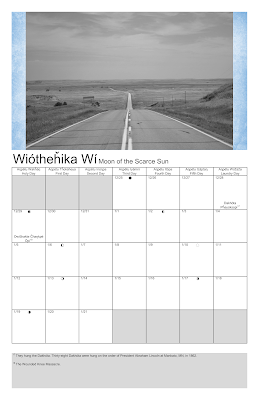For a great explanation of the traditional moon calendar get yourself a copy of "Moonstick: The Seasons of the Sioux," which was reviewed and checked by Mr. Raymond Winters (Fighting Bear), an enrolled member of the Standing Rock Sioux Tribe.
Haŋwí Wówapi 2019A 2019 Lakota Calendar
By Dakota Wind
Bismarck, ND - For the Lakȟóta, the New Year begins in spring, and lasts until the next spring. A year is called Waníyetu or winter because winter is the longest season on the Northern Plains. The new month begins with the new moon. A month is called Wí. The sun is also called Wí. To differentiate between the luminaries, the moon is sometimes referred to as Haŋwí (Night-Luminary), and the sun as Aŋpétuwi (Day-Luminary).
The eight phases of the moon are:
Wit’é (Moon-Died) The New Moon.
Wílečhala (Moon To-Be-Recent). The Waxing Crescent between the New Moon and the First Quarter.
Wíokhiseya (Moon Half-Of). The First Quarter of the moon.
Wímimá Kȟaŋyela (Moon-To-Be-Round Near-By). The Waxing Gibbous between the First Quarter and the Full Moon.
Wímimá (Moon-To-Be-Round). The Full Moon.
Wí Makȟáŋtaŋhaŋ Ú (Moon From-The-Earth To-Be-Coming Here). The Waning Gibbous between the Full Moon and the Third Quarter.
Wiyášpapi (Moon-To-Bite-A-Piece-Off-Of). The Third Quarter of the moon.
Wit’íŋkta Kȟaŋyéla (Moon-Wears-About-The-Shoulders Near-By). The Waning Crescent between the Third Quarter and the New Moon.
The Thítȟuŋwaŋ (the Teton, or Lakota) regard the moon in a feminine sense. There is no “man on the moon,” but an old woman in the moon whom they call Hokhéwiŋ. When a ring around the moon appears it is called Wíačhéič’ithi (The Sun Makes A Campfire For Itself); when a ring appears around the moon they say that Hokhéwiŋ has vigorously stirred her pot and the light has spilled out and around her lodge.
Wíačhéič’ithi is also a reference to sundogs. Long ago, a man went out to pray when the cold gray winter seemed to linger too long. The constant bleak gray days began to effect the people’s dreams. He came back and instructed the camp to select two groups of youth to go out east of camp and build to fires, then to return. Everyone came together in the center of camp and prayed. The sun broke through the clouds and as it rose into the sky, the two fires rose into the sky with it. For the Húŋkpapȟa, the sundog is a promise of hope and light.
The Thítȟuŋwaŋ have two differing explanations for the cycles of the moon. The Húŋkpapȟa say that a large Itȟúŋkala (mouse) with a pointed nose gradually eats away the lodge of Haŋwí until there is nothing left (the waning of the moon). Haŋwí then has to reconstruct her lodge (the waxing of the moon). The Oglála say that Haŋwí draws her shawl over either side of her face as Wí approaches her or withdraws from her.
Like other cultures, the Očhéthi Šakówiŋ recognize four seasons. These are: Wétu (Spring) which is two months; Blokétu (Summer) which is four months; Ptaŋyétu (Fall) which is two months; Waníyetu (Winter) which is five months. The changes of seasons are caused by the eternal conflict of two brothers: Wazíya (the North) and Ókaǧa (the South). If Wazíya plays his flute during summer rains, he causes it to freeze, making hail. When Wazíya wins, we have winter; when Ókaǧa wins, we have summer.
The Očhéthi Šakówiŋ used to keep track of the days, months, and year with Čhaŋwíyawa (Counting Stick/s). Some might use thirteen sticks, one for each month in the lunar year; others might just use one willow switch and notch it (one for a day, or one for each month). Čhaŋwíyawa are recognized more for their use in hand games (a traditional guessing game) than for tracking time.
This calendar includes memorial days of some massacres and major conflicts. This 2019 moon calendar overlaps with part of December 2018 through part of January 2020.
This year's calendar is made with the gracious assistance of Mr. Dustin White and Mr. Doug Wurtz. Both have allowed me to use their photographs to complete this year's calendar. Their names appear next to their photographs.
















No comments:
Post a Comment